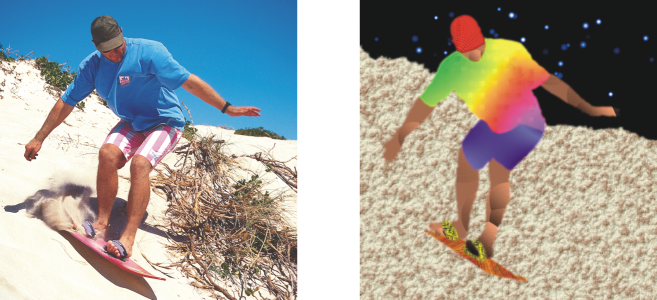Texture fills
Texture fills are three-dimensional patterns. You can use existing texture fills, such as water, minerals, and clouds, or you can edit a texture to create your own texture fill. You cannot import files to use as texture fills.
When you edit a texture fill, you can modify its parameters, such as softness, density, brightness, and colors. Parameters vary for each texture. After you have edited a texture fill, you can save it for future use.
You can modify the attributes of a texture fill to change its appearance.
To apply a texture fill

1
In the toolbox, click the
Fill tool

.
If you want to fill an
object, you must select it by using the
Pick tool

before applying the fill.
2
Click the
Texture fill button

on the property bar.
3
Click the
Edit fill button

on the property bar.
4
In the
Edit fill dialog box, choose a texture library from the
Texture library list box.
5
Choose a texture from the
Fill picker.
6
Click where you want to apply the fill in the image.
|
|
|
Edit the texture fill parameters |
In the Edit fill dialog box, type values in the texture parameter boxes. The parameters vary depending on the texture. |
Preview random changes in the appearance of a selected texture |
Click the Randomize button. Each time the button is clicked, random changes are made to unlocked parameters, and the modified texture is displayed in the Preview window. |
Arrange the tiles so that alternating tiles are reflections of each other |
Click Transformations, and click the Mirror tiles horizontally or the Mirror tiles vertically button. |
Change the size of the fill |
Click Transformations, and type values in the Fill width and Fill height boxes. |
Move the center of the fill up, down, left, or right |
Click Transformations, and type values in the X and Y boxes. |
Rotate the fill at a specified angle |
Click Transformations, and type a value in the Rotate box. |
Slant the fill at a specified angle |
Click Transformations, and type a value in the Skew box. |
Specify a row or column offset as a percentage of the tile’s width or height |
Click Transformations, and click the Row offset or the Column offset button. Type a value in the % of tile box. |
Specify the bitmap resolution of the texture fill |
Click Texture resolution and size, and type a value in the Bitmap resolution box. |
|
|
Click the Save texture button  , and type a name in the Texture name box in the Save texture as dialog box. Choose a library from the Library name list box. |
Specify a value for the opacity of the fill |
Type a value in the Fill transparency box on the property bar. Higher values increase the transparency. |
Specify how the fill spreads based on the color similarity of adjacent pixels |
Type a value in the Tolerance box on the property bar. A value of 100 fills the entire object or area. |
Change the way colors are combined |
Choose a merge mode from the Merge mode list box on the property bar. |
